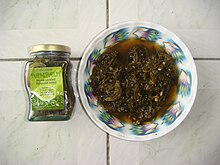 Papaya atchara Papaya atchara | |
| Alternative names | Atsara, Achara |
|---|---|
| Place of origin | Philippines |
| Serving temperature | side or main |
| Main ingredients | unripe papaya |


Atchara (also spelled achara or atsara) is a pickle made from grated unripe papaya originating from the Philippines. This dish is often served as a side dish for fried or grilled foods such as pork barbecue.
History
Main articles: History of pickling and its transmission and History of Filipino cuisineThe name atchara originated from the Indian achar, which was transmitted to the Philippines via the acar of the Indonesia, Malaysia, and Brunei.
Preparation
The primary ingredient is grated unripe papaya. Carrot slices, julienned ginger, bell pepper, onion and garlic make up the other vegetables. Raisins or pineapple chunks may be added, and chilis, freshly ground black pepper, red pepper flakes, or whole peppercorns complete the mixture. These are then mixed in a solution of vinegar, sugar/syrup, and salt preserves.
The mixture is placed in airtight jars where it will keep without refrigeration; however, once opened, it is preferably kept chilled to maintain its flavor.
Variants

- Atcharang maasim (sour pickles) - is prepared in the same way as normal Atchara except that no sugar is added.
- Atcharang labóng (pickled bamboo shoots) - are prepared in the same way as Atchara, but use bamboo shoots instead of papaya.
- Atcharang dampalit (pickled sea purslane) - made from Sesuvium portulacastrum, called dampalit in Tagalog.
- Atcharang ubod (pickled palm hearts) - made from palm hearts, called ubod in Tagalog.
- Atcharang sayote (pickled chayote) - made from chayote, bell pepper, carrots, and ginger.
See also
- Philippine condiments
- Acar – Vegetable pickle made in Indonesia, Malaysia, Singapore, Philippines and Brunei.
- South Asian pickle – Pickled varieties of vegetable and fruit
- Green papaya salad – Spicy salad made from unripe papaya
- Pickled cucumber – Cucumber pickled in brine, vinegar, or other solution
- Pickled onion – Onions pickled in a solution of vinegar or salt
- Sauerkraut – Finely sliced and fermented cabbage
- Tsukemono – Japanese preserved vegetables
- Curtido – Fermented cabbage relish from Central America
- List of fermented foods
 Food portal
Food portal
External links
 Media related to Atchara at Wikimedia Commons
Media related to Atchara at Wikimedia Commons
References
- Zabilka, G. (2007). Customs and Culture of the Philippines. Tuttle Publishing. p. pt111. ISBN 978-1-4629-1302-2. Retrieved November 3, 2017.
- "Pickles Throughout History". Retrieved February 15, 2018.
- "A Brief History Of The Humble Indian Pickle". theculturetrip.com. July 20, 2016. Retrieved November 28, 2016.
- ^ Dagoon; et al. (1997). Culinary Arts II. Rex Bookstore, Inc. ISBN 978-971-23-2157-3.
- Jesse D. Dagoon (1989). Applied nutrition and food technology. Rex Bookstore, Inc. ISBN 978-971-23-0505-4.
- "Atsarang Dampalit". Provincial Government of Bulacan, Philippines. Archived from the original on February 8, 2012. Retrieved September 23, 2012.
- "Atsarang Dampalit". Market Manila. May 25, 2009. Retrieved September 23, 2012.
- "Ubod / Heart of (Coconut) Palm". Market Manila. February 21, 2008. Retrieved September 23, 2012.
- "Chayote Pickles". Putahe ni Aling Mading. Retrieved July 12, 2019.
- "Atsarang Sayote". Foodipino. Retrieved July 12, 2019.
